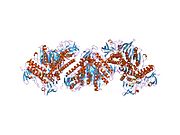| TXNRD1 |
|---|
 |
| Available structures |
|---|
| PDB | Ortholog search: PDBe RCSB |
|---|
| List of PDB id codes |
|---|
2CFY, 2J3N, 2ZZ0, 2ZZB, 2ZZC, 3QFA, 3QFB |
|
|
| Identifiers |
|---|
| Aliases | TXNRD1, GRIM-12, TR, TR1, TRXR1, TXNR, thioredoxin reductase 1 |
|---|
| External IDs | OMIM: 601112; MGI: 1354175; HomoloGene: 55733; GeneCards: TXNRD1; OMA:TXNRD1 - orthologs |
|---|
| Gene location (Human) |
|---|
 | | Chr. | Chromosome 12 (human)[1] |
|---|
| | Band | 12q23.3 | Start | 104,215,779 bp[1] |
|---|
| End | 104,350,307 bp[1] |
|---|
|
| Gene location (Mouse) |
|---|
 | | Chr. | Chromosome 10 (mouse)[2] |
|---|
| | Band | 10|10 C1 | Start | 82,669,785 bp[2] |
|---|
| End | 82,733,546 bp[2] |
|---|
|
| RNA expression pattern |
|---|
| Bgee | | Human | Mouse (ortholog) |
|---|
| Top expressed in | - stromal cell of endometrium
- islet of Langerhans
- right adrenal gland
- right adrenal cortex
- left adrenal gland
- left adrenal cortex
- right coronary artery
- pericardium
- left coronary artery
- nasal epithelium
|
| | Top expressed in | - somite
- otic placode
- otic vesicle
- stroma of bone marrow
- primitive streak
- endothelial cell of lymphatic vessel
- ganglionic eminence
- saccule
- epiblast
- gastrula
|
| | More reference expression data |
|
|---|
| BioGPS | |
|---|
|
| Gene ontology |
|---|
| Molecular function | - protein-disulfide reductase activity
- methylselenol reductase activity
- flavin adenine dinucleotide binding
- methylseleninic acid reductase activity
- protein binding
- electron transfer activity
- oxidoreductase activity
- oxidoreductase activity, acting on a sulfur group of donors, NAD(P) as acceptor
- thioredoxin-disulfide reductase activity
| | Cellular component | - cytoplasm
- extracellular exosome
- nucleus
- fibrillar center
- nucleoplasm
- mitochondrion
- cytosol
| | Biological process | - nucleobase-containing small molecule interconversion
- selenium compound metabolic process
- signal transduction
- cellular oxidant detoxification
- response to oxygen radical
- cell redox homeostasis
- regulation of lipid metabolic process
- cellular response to oxidative stress
- mesoderm formation
- gastrulation
- cell population proliferation
- electron transport chain
| | Sources:Amigo / QuickGO |
|
| Orthologs |
|---|
| Species | Human | Mouse |
|---|
| Entrez | | |
|---|
| Ensembl | | |
|---|
| UniProt | | |
|---|
| RefSeq (mRNA) | NM_182743
NM_001093771
NM_001261445
NM_001261446
NM_003330
|
|---|
NM_182729
NM_182742 |
| |
|---|
NM_001042513
NM_001042514
NM_001042523
NM_015762 |
|
|---|
| RefSeq (protein) | NP_001087240
NP_001248374
NP_001248375
NP_003321
NP_877393
|
|---|
NP_877419
NP_877420 |
| |
|---|
NP_001035978
NP_001035979
NP_001035988
NP_056577 |
|
|---|
| Location (UCSC) | Chr 12: 104.22 – 104.35 Mb | Chr 10: 82.67 – 82.73 Mb |
|---|
| PubMed search | [3] | [4] |
|---|
|
| Wikidata |
| View/Edit Human | View/Edit Mouse |
|

 1h6v: MAMMALIAN THIOREDOXIN REDUCTASE
1h6v: MAMMALIAN THIOREDOXIN REDUCTASE 2cfy: CRYSTAL STRUCTURE OF HUMAN THIOREDOXIN REDUCTASE 1
2cfy: CRYSTAL STRUCTURE OF HUMAN THIOREDOXIN REDUCTASE 1




















